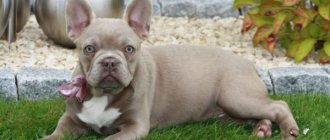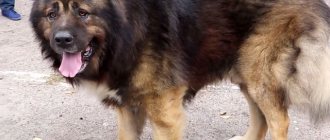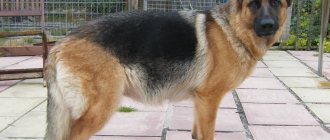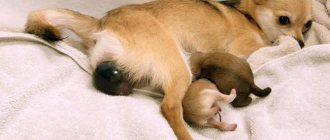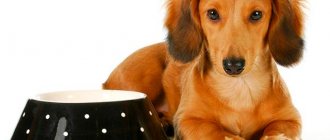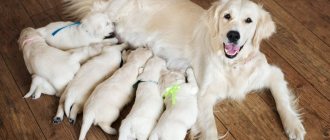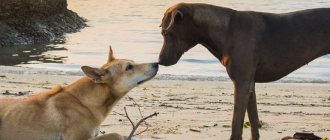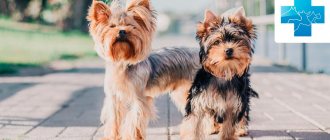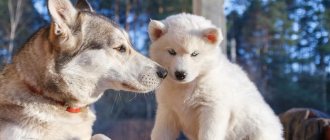Labrador Pregnancy and childbirth is a joyful event for the whole family. It is important for the dog owner to know the first signs and how long the Labrador's pregnancy lasts in order to determine the due date. Often owners are interested in Labrador's pregnancy week by week or day by day. It is important to know what to feed your dog during pregnancy. You need to make sure that this is not a false pregnancy. The main goal of the owner is the birth of healthy puppies and maintaining the health of the mother. To avoid mistakes when breeding a Labrador, you need knowledge. Therefore, we will try to answer all these questions.
How many times a year does a Labrador go into heat?
Frequency Dogs come into heat 1-2 times a year. It depends on the breed and living conditions. For example, domestic dogs come into heat twice a year, while among domestic dogs and those living in the northern regions, this process usually occurs once a year.
Interesting materials:
How to get muted green? How to get a prize from Lays? How to get food cards? How to get a food package in Magnitogorsk? How to get a food set in St. Petersburg? How to become a nurse? How to get a promotional code for thank you bonuses? How to get a promotional code from an aliexpress seller? How to get a pass via SMS in Moscow? How to get dusty pink?
False pregnancy of a Labrador: signs, danger
False pregnancy in a Labrador is a condition that causes signs of expecting puppies. It manifests itself as behavioral or physiological symptoms.
Behavioral signs include:
- Restless behavior of a Labrador.
- The dog diligently arranges a place for future babies. Then he begins to take care of some objects. For example, these could be toys. They replace puppies for a dog.
- Begins to protect his place and imaginary children.
- If there are other people's puppies nearby, the dog actively takes care of them.
Physiological signs include:
- Changes in body structure.
- The belly is growing in size.
- The nipples swell and enlarge. They may become inflamed, as will the surrounding skin.
- The body swells.
- Experienced females show signs of labor.
- Sometimes vomiting occurs.
- There is lethargy and drowsiness.
A false pregnancy in a Labrador can appear 6-10 weeks after mating. The reasons have not yet been reliably studied. It is believed that there is a hormonal imbalance. It is possible that embryos die at the initial stages of development. Or the egg was not fertilized.
To determine if a retriever has a false pregnancy , carefully observe:
- A truly pregnant bitch does not begin to take care of and protect her toys.
- During real pregnancy, the hair around the nipples thins. Because future puppies must find their way to their mother's milk by touch.
- Precursors to childbirth are temperature fluctuations during the day. This is not the case with a false pregnancy.
A Labrador's false pregnancy lasts from a week to a month. This condition should go away on its own.
But, if you see that it is bothering your dog, contact a veterinary clinic. To avoid complications, it is better to examine the dog. For example, infection of the uterus or mammary glands may occur. In addition, signs of a false pregnancy in a retriever must be differentiated from diseases of the pituitary gland or thyroid gland.
If a Labrador's false pregnancy recurs regularly, pyometra or mammary cancer may develop. The doctor should order an ultrasound and laboratory tests.
How many puppies can a female American Cocker Spaniel give birth to?
Thoughts of the owners
Sweet Poison
From 1 to 6. If you do not take into account the options when something went wrong during birth and all the puppies died. Or if your dog is not a hero. An Irish Setter gave birth to 15 puppies - this is a record.
Shadow
Depends on the bitch, male, day of mating and the presence of a control mating, so a dog can bring from 1 to 16 puppies (does not depend on the breed)
Video
What not to feed
There are foods that dogs of any age and physiological condition should not be fed. Do not give them to your pets under any circumstances.
- Refined sugar: will lead your Labrador to obesity and unbalanced diet. Chocolate is dangerous: the more cocoa it contains (dark varieties), the more caffeine and theobromine, the more likely convulsions, tremors, arrhythmia, and increased thirst are.
- Fat: heavy fatty food will “give” your Labrador problems with the liver and inflammation of the pancreas.
- Salty, smoked, spicy, spices: the first and second will cause severe thirst and, as a result, expansion of the stomach and intestinal volvulus; the third and fourth will ruin the dog’s sense of smell.
- Bones: fish - will get stuck in the throat, cause inflammation, and it will be difficult for the dog to breathe; tubular - sharp fragments will injure the oral cavity, esophagus, stomach and intestines; raw ones are a source of parasites.
- Potatoes, pasta: labs do not digest starch well, and gluten in wheat flour is the cause of allergies.
Postpartum period
Within 36 hours after birth, the owner must carefully monitor the condition of the dog and its offspring. In the first three weeks you should refuse to receive guests. It is also necessary to protect the dog from sharp sounds and other irritating factors.
Newborn puppies should drink milk and gain weight. If there is a lag in weight gain, then complementary foods are introduced to stabilize the process.
Within a month, brown mucus will come out of the female’s genital tract. If purulent or bloody-purulent discharge appears, you should immediately seek help from a veterinarian. The fact is that complications after childbirth in dogs are not uncommon (they are dangerous because they can cause inflammation of the uterus, as well as lead to other dangerous consequences).
Mom with puppies
Sometimes it happens that a dog breathes frequently after giving birth. This may happen immediately or several days after the event. On average, the pet's respiratory rate should be 10-30 times per minute. You can count them by observing the “movement” of the ribs or by placing your hand on them. The smaller the dog, the faster it breathes.
Another sign of rapid breathing is that it is superficial (that is, it is not done deeply). Sometimes such a deviation is normal if it occurs immediately after childbirth (this is due to contraction of the muscles of the uterus in order to push the placenta out). As a rule, this condition continues for 15 minutes after the birth of the last puppy.
Natural diet
When feeding your dog natural food, you must remember: you will have to balance the nutrition in terms of nutrient content yourself, and this is not easy. Please note that it will take a lot of time and effort to prepare. Meat should be at least 50% in the diet, because dogs are carnivores. You should not feed your Labrador retriever food that is too hot or cold, stale, or improperly heat-treated (fried). Preferred Products:
- Lean meat (beef, turkey, chicken, horse meat, rabbit), offal: types that do not cause allergies, boiled, frozen or scalded, cooked offal, raw tripe, unpeeled;
- Sea fish: boneless (hake, cod, pollock), boiled to bind trimethylamine oxide, which causes anemia in animals;
- Dairy products (yogurt, yogurt, bifivit, cottage cheese, low-fat cheese), fresh milk (only for puppies up to 8 weeks old, a little at a time). Add calcium chloride to the milk feed (2 tablespoons per liter before boiling the milk);
- Porridge (rice, buckwheat), flavored with rye breadcrumbs and vegetable oils (linseed, sunflower, olive);
- Eggs (raw (with porridge) only the yolk, boiled or as an omelet - whole);
- Fruits (little by little, except grapes), vegetables (raw grated zucchini, carrots, pumpkin), herbs (dill, parsley, celery).
Sample menu for the week
| Day of the week | Menu |
| Monday | In the morning - cottage cheese with sour cream, fresh vegetables, in the evening - boiled beef, in pieces, with rice boiled in broth; |
| Tuesday | In the morning - an omelet with vegetables and cheese, raw beef, in the evening - chicken breast with buckwheat and herbs or fish; |
| Wednesday | like on Monday; |
| Thursday | like Tuesday; |
| Friday | In the morning - fresh vegetables, chopped, beef meat, raw, cut into pieces, in the evening - chicken fillet with rice; |
| Saturday | In the morning - cottage cheese with bifidok, porridge with vegetables, in the evening - beef with buckwheat and herbs; |
| Sunday | In the morning - porridge with breadcrumbs and herbs, cottage cheese. In the evening - boiled offal (raw tripe) with buckwheat. |
Rating of quality food for adult retrievers
Eukanuba Breed Specific Dry Dog Food For Labrador Retriever
Products from an American manufacturer. The composition belongs to the specialized category. Takes into account the size of the animal and its preferences. Composition of granules:
- dehydrated chicken;
- fish flour;
- cereals;
- chicken fat;
- beet pulp;
- egg powder.
Hydrolyzate from cartilage and crustacean shells will help joints develop. Proteins and fats are balanced, which allows the animal not to gain excess weight. Thanks to the presence of L-carnitine, natural fat burning and strengthening of the cardiovascular system occurs.
You can purchase the products at a price of 5,600 rubles per 12 kg.
Eukanuba Breed Specific Dry Dog Food For Labrador Retriever
Advantages:
- promotes a nutritious diet;
- advanced functionality;
- the presence of a complex of vitamins and minerals;
- value for money.
Flaws:
- the presence of corn in the composition can cause allergies.
Hill`s Nature`s Best Canine Adult Large Breed/Giant dry
It is recommended to purchase for those who have a real giant (over 25 kg). It is based on turkey and chicken meat. Protein at 22.7%. Allows dogs to develop normally and not gain excess weight. Fats within 14.5%. The composition is filled with natural antioxidants. No flavorings or dyes are used in production. The presence of chondroprotectors contributes to the proper development of joints. Taurine has a positive effect on the functioning of the heart muscle. Metabolism regulation is carried out due to the presence of L-carnitine.
The average price for a 12 kg package is 5345 rubles.
Hill`s Nature`s Best Canine Adult Large Breed/Giant dry
Advantages:
- included in the TOP of sold products;
- food is enriched with minerals and vitamins;
- minimizes the possibility of obesity;
- no wheat or soy.
Flaws:
- Not suitable for nursing individuals.
Acana Grass-Fed Lamb
Product from a Canadian manufacturer. Belongs to the high quality category. The production uses lamb meat (50% of the composition), as well as vegetables and fruits. The manufacturer uses only fresh ingredients. The shape is optimal for large active dogs. Along with easily digestible meat, the ingredients include seaweed, butternut squash, cartilage, kidneys, tripe, and apples. Proteins and fats in a ratio of 31% to 15%. The granules are large. Chewing them cleans the teeth and gums.
The purchase price is 8,673 rubles per 17 kg package.
Acana Grass-Fed Lamb
Advantages:
- hypoallergenic product;
- balanced composition;
- quality of ingredients used;
- the presence of medicinal herbs and a vitamin-mineral complex;
- value for money;
- positive reviews.
Flaws:
- no zip fastener.
Royal Canin Labrador Retriever Adult
The products are produced for use by Labradors. You can give it starting from 15 months. Contains proteins (30%) and fats (13%). The composition is based on yeast, borage oil, beet pulp, plantain seeds, fish oil, cartilage hydrolysate, plant extracts. L-carnitine has a positive effect on the gastrointestinal tract. Ideal for pregnant and lactating bitches. Can be purchased at a specialized retail outlet or ordered online in an online store. Reviews are positive.
Purchase price – 1313 rubles per 3 kg.
Royal Canin Labrador Retriever Adult
Advantages:
- ease of use;
- balanced formula;
- versatility;
- beneficial effect on the functioning of vital organs.
Flaws:
- presence of corn and wheat gluten.
Advance Labrador Adult
The food fully provides adult dogs with beneficial vitamins and minerals, as well as microelements. In production, chicken meat, green peas, yeast, barley, dehydrated eggs, fish oil, whole grains of corn and wheat, and carrots are used. Protein level – 29%, fat – 14%. Calorie content at optimal level. Does not contribute to excess weight gain. In high demand among retrievers. Does not cause allergic reactions.
Retailers offer the product at a price of 3,500 rubles per 12 kg.
Advance Labrador Adult
Advantages:
- suitable for allergy sufferers;
- quality composition;
- the presence of L-carnitine and taurine;
- value for money.
Flaws:
- there are supply interruptions;
- no small packaging.
Maxi's Meal
Products from a domestic manufacturer. It has a balanced composition. Only fresh ingredients, grains and vegetable oils are used for preparation. Eating such granules makes your pet's fur smooth and its skin healthy. The composition contains vitamin D, which has a beneficial effect on cartilage and ligaments. Dogs like the taste.
The average cost is 1200 rubles per 10 kg.
Maxi's Meal
Advantages:
- presence of useful components;
- proven brand;
- value for money;
- granules clean gums and teeth.
Flaws:
- the presence of a large amount of corn flour.
Bosch Maxi Adult
The product is manufactured by a German company. Dog breeders note the high protein content in the product and the use of high-quality meat in production. The food contains fatty acids, minerals, and shellfish extracts, which prevent cartilage from deteriorating. This is quite important for retrievers, whose cartilage bears a significant load. The amount of protein is small, so it is not suitable for nursing pets and puppies.
The average price for a 15 kg package is 5,756 rubles.
Bosch Maxi Adult
Advantages:
- excellent quality;
- rich in minerals;
- value for money;
- positive reviews;
- time-tested manufacturer.
Flaws:
- presence of allergens.
Farmina N&D, lamb, with quinoa
The product is characterized by low fat content and the ability to curb the appearance of extra pounds. Producing countries: Italy and Serbia. An ideal product for Labradors who are not averse to eating tasty and healthy food. The formula is balanced, dietary. Allows you to maintain weight without feeling hungry. The products belong to the holistic class. Improves diet for overweight, sedentary and sterilized dogs. The basis of the composition is lamb meat (40%). The remaining share comes from flax seeds, fish, peas, broccoli, asparagus, quinoa, which increase immunity and make the gastrointestinal tract work more stable.
Purchase price – 6030 rubles per 7 kg.
Farmina N&D, lamb, with quinoa
Advantages:
- helps maintain good physical shape;
- balanced monoprotein formula;
- dietary product;
- gives strength and endurance;
- high quality ingredients.
Flaws:
- not identified.
How to care for newborn puppies
For the first 2 weeks, weigh the puppies every other day and record the results in a chart. This will help monitor the development of babies.
If the puppy is developing well, then he actively reaches for food and pushes. When, on the contrary, the baby moves poorly, eats poorly, and does not gain weight well, he needs increased attention.
In the first days of life, puppies find it difficult to go to the toilet on their own. Therefore, they may become restless. The bitch should massage their bellies with her tongue to help release the bowels and bladder.
At birth, the puppy is blind and deaf, since their eyes and ears are still closed.
The baby has poor thermoregulation, so it is easy to overheat or overcool. Therefore, monitor the temperature in the puppies' box so that they do not die.
When the puppy is comfortable and has enough milk, he quickly falls asleep and sleeps well.
At 7-10 days , the puppies' eyes open. Then in 10-15 days they begin to see.
At 2 weeks the ear canals open. From this same period, teeth begin to erupt.
Up to a month old, puppies' bodies twitch slightly.
By the 18th day of life, puppies learn to bark and play. Then they confidently stand on their feet.
By the end of the 3rd week, they begin to go to the toilet on their own without mother’s help.
At 4 weeks old , the puppies actively play with each other, run around, and play around. They enjoy people's attention. At this time you can watch them for hours, they are so funny. They are already eating from a saucer on their own.
By this time, they become similar to adult Labradors.
Stage 4. Let's relax!
Preferably without alcohol (at least, take turns!).
And here we pay attention to the woman in labor. What is she doing?
- Digging? These are contractions, so she extinguishes them.
- Puffing? Contractions too! If you gave birth or saw it on TV, then remember the doctors’ order: “Breathe like a dog!”
- Is she shivering? See above.
- Smiling?
Many owners do not understand this question and believe that I am making fun of them in this way. A dog that smiles cannot be confused with any other dog! This means that we are almost ready: the eyes are happy, the posture is relaxed, the puppies hardly move, the ear is turned towards the pelvis (i.e. towards the puppies). All intermediate states from rehearsal to the birth itself are described in detail in the literature, but we approach our dog individually!
So. At one point, water pours out of the loop (this is the place where the dog pees). It can be transparent, with flakes, with greenery - the main thing is that it pours out quickly and is not controlled by the bitch. She is terribly interested in this and tries to suck it up. Very often it is in this bent position that the first puppy appears. BUT!!! This is not a fact! The bitch gives birth to her first child in a position that is comfortable for HERSELF. This can be a defecation position (pooping), lying on your side, standing on your hind legs with your front legs on a table, etc. The main thing is to accept this puppy correctly, it will be easier in the future!
Let's continue. From the loop appears something similar to a bubble, a paw, a nose (although in our breed everything is much simpler!). The loop, which before giving birth began to look like the dangling trunk of an elephant, is filled with a hard mass, while the bitch withdraws her tail (remember mating!) and makes pushing movements. Was there ointment somewhere? Lubricate the index finger (with short-cut nails) and from the side of the tail insert it into the loop along the puppy or bubble in which it is located. Your finger will rest against a bridge that looks like a constriction. As a rule, this is where puppies get stuck. This is the narrowest place for childbirth.
Having given birth to the head (or body), the bitch calms down and does not want to give birth further, she feels better. Here she is trying to sit on her butt. Attention! A fracture of the puppy's cervical vertebrae is possible. Your task is to prevent her from doing this. One of the assistants holds the bitch either in a standing position or in a position lying on its side. You “dive” under the jumper with your finger and gently (like snot from your nose) circle the puppy. The dog immediately pushes and “spits out” the fetus.
Don't relax!!!! Following the puppy comes the placenta, which is connected to the puppy by the umbilical cord (this is a cord from the tummy), pinch the umbilical cord with two fingers and, without releasing it, gently pull it along with the puppy. If a piece of “liver” (maybe green) falls out, then everything is great, it’s the afterbirth. If not, then the umbilical cord breaks. Don't be scared!!! Happens. Just make a note for yourself - write down on a piece of paper the time of birth and the absence of an afterbirth.
You grab the puppy in your hands and leave the bitch alone. Take care of your child. Instructions for right-handed people:
- Puppy in your left hand, belly in your palm, tail towards your chest. Hold it slightly upside down;
- With the diaper in your right hand, rub the back vigorously in both directions along the spine. Don't be afraid, the puppy is not as weak as you think!
- Turn the puppy's head towards you and open his mouth (squeeze the jaw on the sides with your fingers), blow off the enema, insert it into the mouth at the base of the tongue (first from one side, then from the other) and suck out the mucus. “Blow” the enema into the diaper. You will see what comes out of it. Then grab the puppy by the withers (like a cat carries kittens) and shake him a little. The puppy should squeak. Listen - the sound should be clear, without wheezing or bubbling. If you don’t like the voice, repeat the enema procedure from the beginning;
- The puppy lost his breath. Hooray! But we have a dangling placenta (or pieces of the umbilical cord). Place the puppy on a dry piece of diaper. Take out the thread (Have you forgotten about it? Threads get wet in alcohol!) and tie the umbilical cord somewhere at a distance of 1-1.5 cm from the tummy, and cut it after another 0.5 cm. Try not to cut off the tail, finger, etc. If the placenta breaks, then use a thread to grab all visible vessels and tie them up. It doesn’t matter at what length!
- You bought green stuff! They found her in a panic! We unscrew the cap and, holding the puppy with its tummy down, as if lowering the remains of the umbilical cord into the bottle. Press the bubble tightly to the tummy and turn the puppy over with the bubble, tummy up, then turn it back. Your belly button has been treated!
What to feed to avoid allergies
There are many allergy sufferers among the labs. Switch your labrador on dry food to a hypoallergenic line. Consistently exclude milk, chicken, beef, soy and wheat from the natural diet, as the animal can react to any of these products. It takes a long time (a month and a half or more), but as a result you will learn how to feed your special dog.
Follow a hypoallergenic diet; it will be prescribed to your pet by a veterinarian. Using a blood test and intradermal tests, he will determine the type of allergen.
What to feed an old dog
Age-related changes in the functioning of the Labrador's body are partially compensated by nutrition. It is corrected like this:
- add vitamins to slow down the withering process,
- reduce portions or calorie content of food (by 20%),
- enrich the diet with calcium for teeth and claws,
- add products with glucosamine (beef, hard cheese, cartilage, skin and tendons, salmon) to prevent arthritis,
- follow general nutritional rules, since older dogs often suffer from indigestion.
History of the breed
Debates still rage about how Labrador got to the Canadian island of Newfoundland. What is known for certain is that it was there that they began to use unusual dogs that incredibly love water and enjoy splashing in it.
Mostly fishermen lived on the island. Every day they practiced their difficult craft, and unusual dogs called Newfoundland dogs helped them in this. There are two known breeds that lived on the island - large and small. Large dogs had long, thick hair, and the hair of small dogs had unusual water-repellent properties. It was this second variety that became the ancestor of Labradors. At that time, the breed was simply called St. John's dogs (from the capital of the province of Newfoundland). All day long the dogs helped catch fish, searched for nets, pulled out fallen prey and brought it to their owner. Later, Labradors began to be used as rescue dogs. So it was considered important to take at least one Labrador on a voyage. In the event of a shipwreck, the dog swam ashore, holding a rope in its teeth, along which fishermen climbed out of the sea.
In the 19th century, dogs began to be exported from the island to the United States and Europe. In European countries, breeding of the breed was difficult, since the exported dog had to undergo a six-month quarantine.
However, despite the difficulties, the Labrador took root in Europe, and later came to Russia. At the end of the 19th century, the first breed standard was adopted, exhibitions began to be held and clubs were created.
Explanations
Here is the first puppy. It's not so scary anymore. There are just little nuances. I'll try to list them:
- The break between puppies fluctuates and is not stable. If the girl behaves normally (i.e. during childbirth), then please do not fuss or make the mother nervous!
- A dog's uterus is NOT designed like a woman's! First, one horn gives birth, and only then the second. Can you imagine a slingshot? So, the break between horns sometimes reaches 6 hours. At this time, the bitch is resting, feeding the puppies, walking around the apartment, etc. I've had bitches eat between puppies!
- If more than 30 minutes have passed since the puppy was born, check for the presence of the puppy in the birth canal. Remember the first puppy? Repeat the procedure, you will just have to go deeper into the uterus. You can feel the puppy. If it doesn't have a bubble, i.e. it broke through (a portion of the water leaked) and 15-20 minutes have passed, then we need to help the girl! Insert your finger (lubricated with ointment!) up to the constriction and begin “stroking” this constriction clockwise until the bitch begins to push. Attention, see step 4.
- The mother needs to be introduced to the puppy. This is not only the moment of contact between the dog and the child, but also the moment of truth - the dog’s trust in you. This must be done carefully, holding the puppy with both hands, as if covering it with your palms. It’s better to bring it up with the back, there’s both the ass and the pussy. The bitch will reflexively begin to lick the puppy. However, this does not apply to spoiled princesses! In front of her, place the puppy in the box, demonstrating that you care for him. Keep your bitch away from family members she doesn't trust (although she'll be quick to point him out!).
Now I want to focus on what is best avoided.
I am a veterinarian and, unfortunately, I know this profession from the inside... The Labrador is considered an expensive dog, but only the owner knows that this dog is more expensive to own than to buy. And yet, they are trying to scam us, the owners, out of money.
Features of feeding during pregnancy and after childbirth
Bitches during pregnancy and lactation are fed fractionally and often - 5-6 times a day. The energy requirement for nursing mothers and bitches is higher. This food regimen for the mother is observed for one and a half to two months after the birth of the puppies. During this period, a special place is occupied by proteins - building materials for the proper formation and growth of babies. If a large litter of puppies is expected, the expectant mother should be fed in small portions. This will prevent excessive stretching of the abdomen.
During lactation, the bitch consumes a large amount of calories. She needs more impressive amounts of food than a dog in her position requires. Food should contain sufficient amounts of protein and fat rich foods. This promotes the production of breast milk and gives the mother energy to feed her babies. With a natural diet, high quality proteins and calcium are sufficient. When feeding a bitch with commercial food, it is worth thinking about additionally introducing fresh, high-protein products into the diet. Suitable raw meat (beef, poultry, lamb, beef by-products: heart and kidneys), goat milk, raw eggs, yoghurt, cheese, cottage cheese, fatty varieties of sea fish (salmon, mackerel).
During the period of bearing offspring, the dog's tastes are often distorted. She may eat foods that she previously refused and ignore foods that she enjoyed eating before conception. At this time, you need to listen to your pet and offer feeding that she likes and matches her instincts.
A pregnant mother will benefit from:
- red viburnum - promotes easier labor, speeds up the process, stimulates milk production;
- kelp and brown seaweed are sources of iron and trace elements;
- fennel - improves digestion, enhances lactation.
Tips, recommendations, life hacks
Be sure to wash the bowl after each feeding to your dog. Even if it seems clean, pathogenic bacteria quickly multiply in the microscopic residues of food.
Dishes for Labrador retrievers should be heavy and unbreakable. The best option is an enamel bowl or stainless steel container on a stand. You can also use ceramic cookware on a secure stand. The bowl should not have cracks or chips, otherwise the pet may injure its tongue while licking the dishes.
Signs of properly selected food and a balanced diet are the pet’s normal weight and activity, as well as smooth, shiny coat. If the coat becomes dull or the Labrador begins to lose or gain weight, contact your veterinarian to adjust his diet.
During pregnancy, a Labrador's taste may change dramatically - this is normal. It is highly advisable for the expectant mother to add seaweed, various berries, especially viburnum, and fennel to her diet. These vitamin supplements promote healthy digestion, speed up labor and are a valuable source of iodine, iron, copper and other minerals.
What not to do
If you want your pet to live longer, you need to know which foods to avoid.
List of foods that should not be given:
- Fatty foods, including fatty meat products.
- Bones. They have no nutritional value. Harmful to teeth, causing constipation, intestinal volvulus and perforation of their walls. Chicken and tubular ones are especially harmful: when chewed, they split into sharp pieces.
- Legumes, pearl barley, semolina and oatmeal. Causes indigestion.
- Potatoes, cabbage. Causes bloating.
- Smoked meats, sausages, frankfurters. They destroy the liver of dogs, leading to the death of young animals.
- Sweets and chocolate. They cause tearing, destroy tooth enamel, disrupt the functioning of the digestive tract and salivary glands, and impair appetite.
- Pickles, marinades, herbs, spices. They impair the sense of smell and harm taste buds. Harmful to the stomach, causing heartburn.
- Milk. Causes diarrhea.
- Bread and other baked goods. Not digestible, contributes to obesity.
- Citrus fruits, avocados, grapes. Broccoli.
